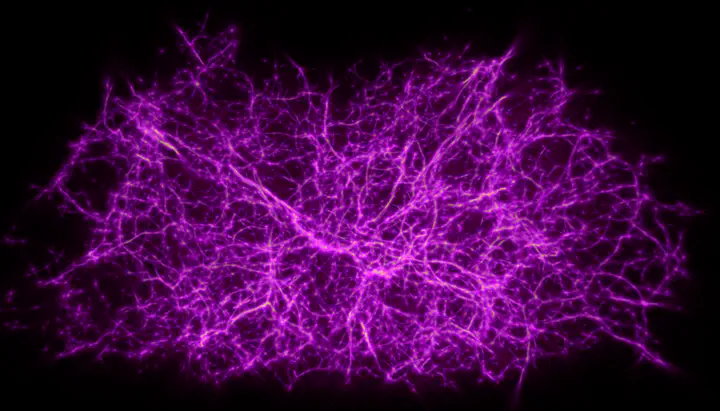PolyPhy

PolyPhy is a GPU oriented agent-based system for reconstructing and visualizing optimal transport networks defined over sparse data. Rooted in astronomy and inspired by nature, we have used an early prototype called Polyphorm to reconstruct the Cosmic web structure, but also to discover network-like patterns in natural language data. You can see an instructive overview of PolyPhy in our workshop and more details about our research here.
Under the hood, PolyPhy uses a richer 3D scalar field representation of the reconstructed network, instead of a typical discrete representation like a graph or a mesh. The ultimate purpose of PolyPhy is to become a toolkit for a range of specialists across different disciplines: astronomers, neuroscientists, data scientists and even artists and designers. PolyPhy aspires to be a tool for discovering connections between different disciplines by creating quantitatively comparable structural analytics.
PolyPhy Web Presence
- Topics:
Web DevelopmentUXSocial Media - Skills: full stack web development, Javascript, good communicator
- Difficulty: Challenging
- Size: Large (350 hours)
- Mentors: Oskar Elek, Ezra Huscher
The online presentation of a software project is without a doubt one of the core ingredients of its success. This project aims to develop a sustainable web presentce for PolyPhy, catering to interested contributors, active collaborators, and users alike.
Specific tasks:
- Closely work with the mentors on understanding the context of the project and its detailed requirements in preparation of the proposal.
- Port the existing website into a more modern Javascript framework (such as Next.js) that provides a user-friendly CMS and admin interface.
- Update the contents of the website with new information from the repository repository page as well as other sources as directed by the mentors.
- Develop a simple functional system for posting updates about the project to selected social media and other communication platforms (LinkedIn, Twitter/X or Mastodon, mailing list) which will also be reflected on the website.
- Optional: improve the UX of the website where needed.
- Optional: implement website analytics (visitor stats etc).
Data Visualization and Analysis with PolyPhy/Polyglot
- Topics:
Data ScienceData VisualizationPoint Clustering3DNeural Embeddings - Skills: data science, Python, Javascript, statistics, familiarity with AI and latent embedding spaces a big plus
- Difficulty: Challenging
- Size: Large (350+ hours)
- Mentors: Oskar Elek, Kiran Deol
The aim of this project is to explore a novel data-scientific usecase using PolyPhy and its associated web visualization interface PolyGlot. The contributor is expected to identify a dataset they are already well familiar with, and that fits the application scope of the PolyPhy/PolyGlot tooling: a complex point cloud arising from a 3D or a higher dimensional process which will benefit from latent pattern identification and a subsequent visual as well as quantitative analysis. The contributor needs to have the rights for using the dataset - either by owning the copyright or via the open-source nature of the data.
Specific tasks:
- Closely work with the mentors on understanding the context of the project and its detailed requirements in preparation of the proposal.
- Become acquainted with the tooling (PolyPhy, PolyGlot) prior to the start of the project period.
- Document the nature of the target dataset and define the complete data pipeline with assistance of the mentors, including the specific analytic tasks and objectives.
- Implement the data pipeline in PolyPhy and PolyGlot.
- Document the process and resulting findings in a publicly available report.
